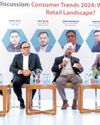
The First Industrial Revolution began in the late 1700s wherein the shift occurred from agrarian to machine and process-driven manufacturing, which led to mass production of goods. Then the telegraph was invented, the advent of railways happened and this led to faster movement of people, raw materials and finished goods. Additionally, electricity reached factories and the Second Industrial Revolution took place.
The first-ever assembly line was successfully created by Oldsmobile as a result of this. The invention and then mass production of computer technology and programmable controls started the Third Revolution in the mid to late 20th Century.
The focus here was on digitalisation in factories, with microprocessors and other technology being used in machines. What we are in the midst of now is the Fourth Industrial Revolution, also known as Industry 4.0, a term coined by the German government.
While the earlier three revolutions did cause major changes, this fourth one is fundamentally different. It brings about the fusing of physical and digital technologies, known together as cyber-physical systems (CPS), and leverages interconnectivity via the Internet of Things (IoT), real-time data analytics, artificial intelligence and cloud computing.
The four core components of Industry 4.0 are:
● Interconnectivity - all moving parts in the manufacturing process namely, machines, devices, sensors and people are connected and communicating with one another via IoT.
● Information transparency data is collected at all intersections and disseminated for informed decision-making.
● Technical assistance intelligent systems assist humans in decision-making and problem-solving, as well as for difficult or unsafe tasks.
● Decentralised decision-making - the ability of systems to take decisions and perform tasks autonomously.
هذه القصة مأخوذة من طبعة December 17, 2022 من Businessworld India.
ابدأ النسخة التجريبية المجانية من Magzter GOLD لمدة 7 أيام للوصول إلى آلاف القصص المتميزة المنسقة وأكثر من 9,000 مجلة وصحيفة.
بالفعل مشترك ? تسجيل الدخول
هذه القصة مأخوذة من طبعة December 17, 2022 من Businessworld India.
ابدأ النسخة التجريبية المجانية من Magzter GOLD لمدة 7 أيام للوصول إلى آلاف القصص المتميزة المنسقة وأكثر من 9,000 مجلة وصحيفة.
بالفعل مشترك? تسجيل الدخول

Technology, AI Driving Warehousing Sustainability
Anshul Singhal on how Welspun One is rapidly transforming Grade-A logistics and industrial parks across India, offering integrated fund development and asset management for large-scale warehousing solutions

DECODING RETAIL'S NEXT FRONTIER
As brands pivot towards omnichannel ecosystems and startups challenge legacy frameworks, the focus sharpens on experiential retail, sustainability and data-driven personalisation.

SORORITY OF WOMEN OF METTLE
Awinter afternoon in mid-December found quite a crowd at the Oxford Book Store on Connaught Place, as bibliophiles congregated at a corner to listen to three women authors, diverse in their passions, but drawn together by an urge to tell their story.

THE LEGACY OF THE AMARNATHS
IN NOVEMBER 2017 the management committee of the Delhi Cricket Association named the eastern stand of the Feroze Shah Kotla ground the Mohinder Amarnath stand.

PUTTING THE POWER IN THE POWERHOUSE
The Asus ExpertBook P5 is powered by an 8-core 8-thread Intel Core Ultra 7 Series 2 processor that clocks a maximum speed of 4.8 GHz, but it does not have hyperthreading. It is light weight, with a smooth glass touch pad. The laptop almost has all the I/O ports you could possibly need in a business laptop, making it an extremely lucrative option for professional computing, says

"We must be aware of our energy and water consumption"
BW Businessworld caught up with actor, philanthropist, and climate warrior BHUMI PEDNEKAR to chat about climate change and more.

"Cooking is a passport to the world"
In conversation with renowned CHEF MANJIT GILL, Advisor at Kikkoman India and President, Indian Federation of Culinary Associations (IFCA). As the former Corporate Chef of ITC hotels, Chef Gill has helped shape iconic restaurants, such as the Bukhara, Dum Pukht, and Dakshin. He has had the privilege of serving former American Presidents Barack Obama, Bill Clinton, George Bush, and the French, Canadian, British and German premiers. In 1992, Chef Gill had the opportunity of being invited to cook for Prince Charles and Lady Diana, at the Palace of the Maharaja of Jaipur. He was awarded the Lifetime Achievement Award from the Ministry of Tourism in 2007.

Strengthening Middle Management for Organisational Resilience
WHAT HOLDS AN organisation together in chaos? Is it visionary leadership, cuttingedge strategies, or robust technology?

The Retail Trailblazers
A look at companies that are making a positive impact on India's growing retail sector with their future fit business and marketing strategies.

Driving Conscious Consumerism
VIDIT JAIN, Co-founder of Kindlife, is leading the charge in revolutionising the intersection of technology and conscious consumerism.